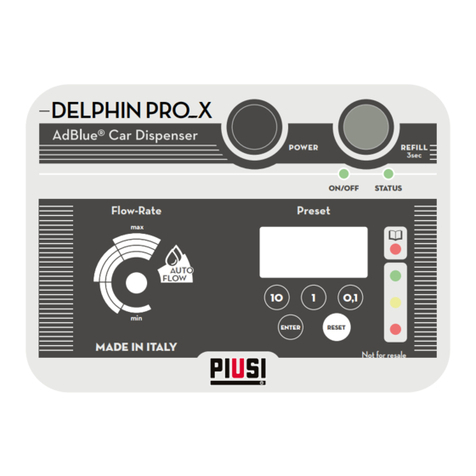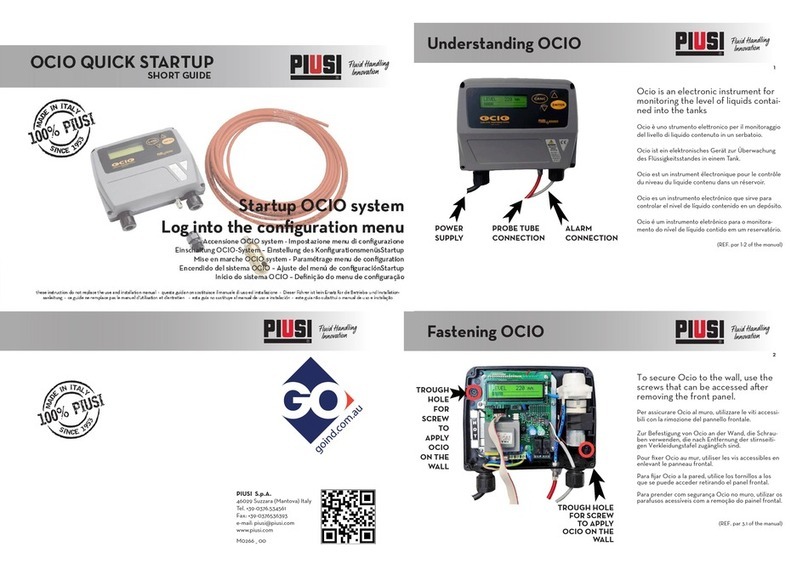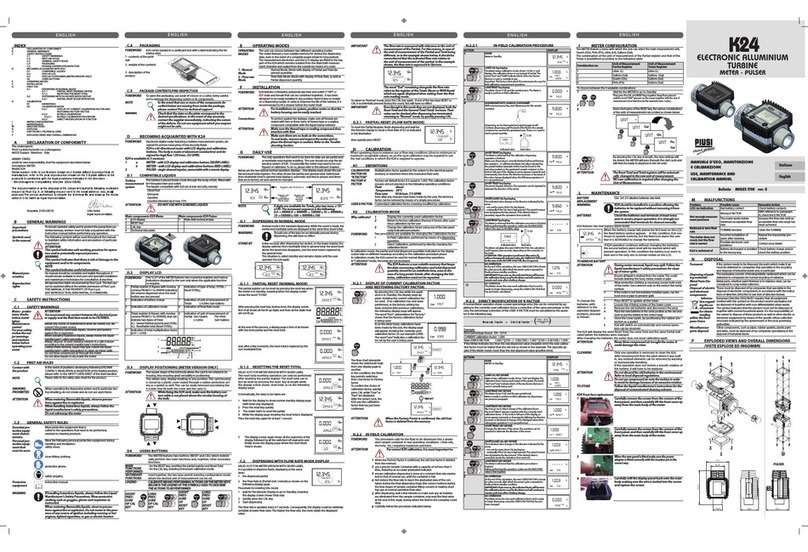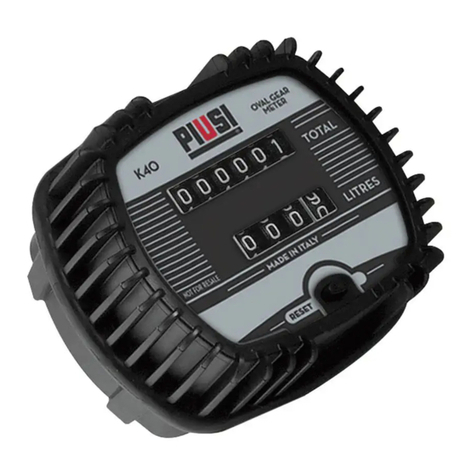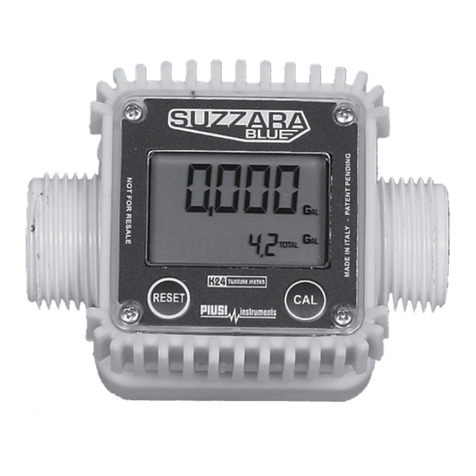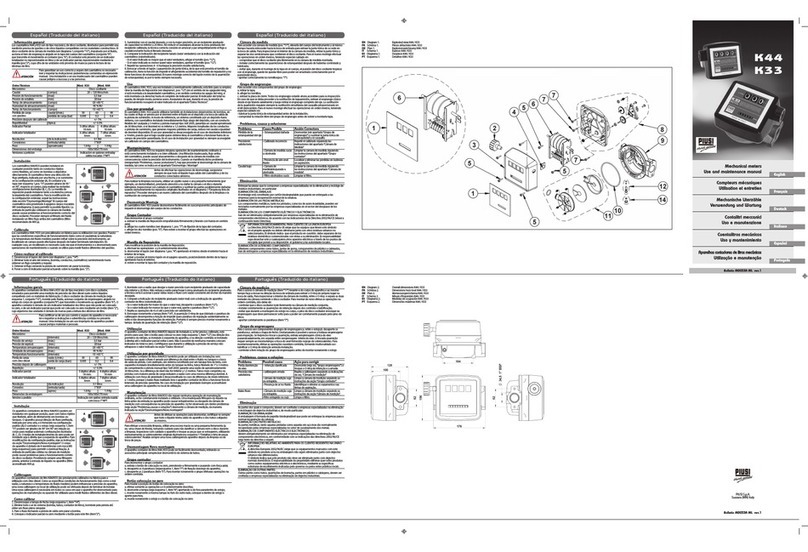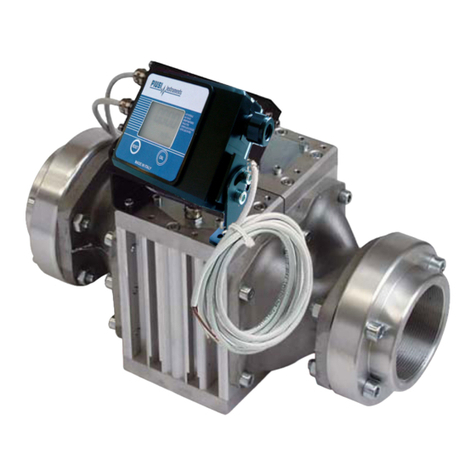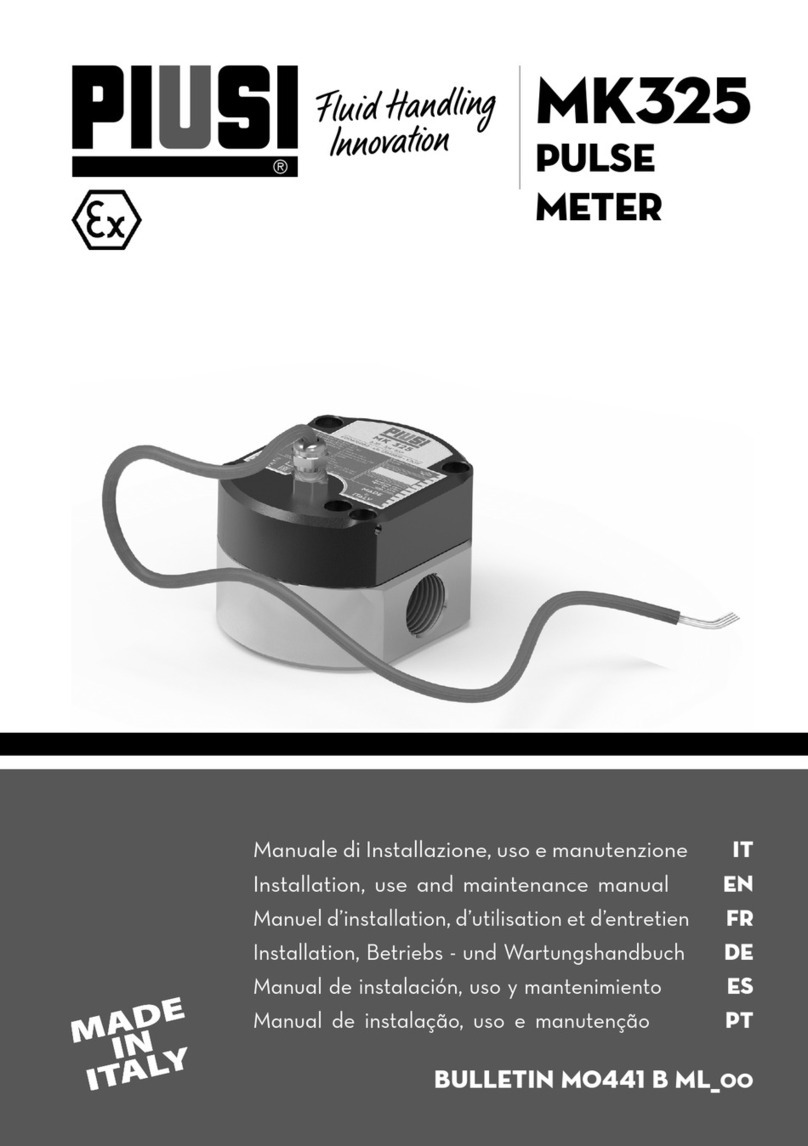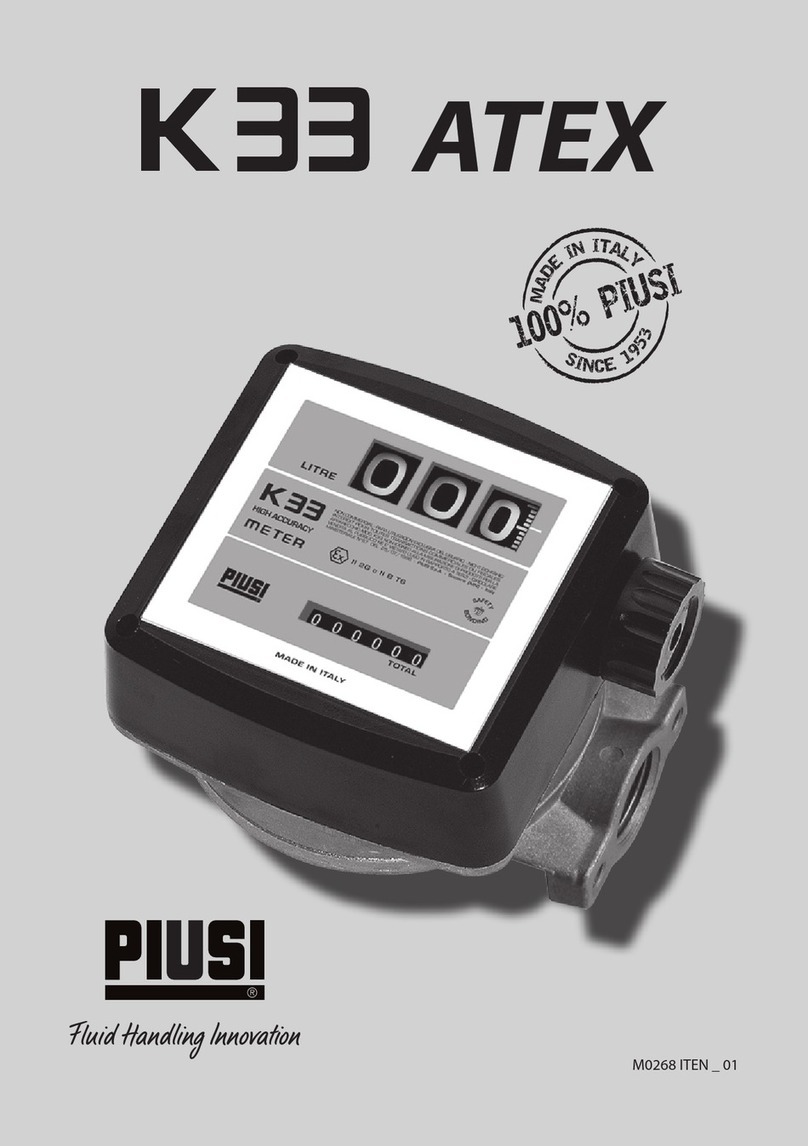ITALIANO (Lingua originale) ITALIANO (Lingua originale) ITALIANO (Lingua originale) ITALIANO (Lingua originale) ITALIANO (Lingua originale) ITALIANO (Lingua originale) ITALIANO (Lingua originale)
A INDICE
A INDICE
B CONFORMITA’
B1DICHIARAZIONE DI CONFORMITÀ (94/9/CE, All. VII)
C DESCRIZIONE DELLA MACCHINA
C1 DEFINIZIONE AREE CLASSIFICATE
C2 DESTINAZIONE D’USO
C3 MOVIMENTAZIONE E TRASPORTO
D AVVERTENZE GENERALI
E NORME DI PRONTO SOCCORSO
F NORME GENERALI DI SICUREZZA
G DATI TECNICI
H CONDIZIONI OPERATIVE
H1 CONDIZIONI AMBIENTALI
H2 FLUIDI AMMESSI
I INSTALLAZIONE
L CALIBRAZIONE
M USO GIORNALIERO
N MANUTENZIONE
O DISSASSEMBLAGGIO E RIASSEMBLAGGIO
P PROBLEMI E SOLUZIONI
Q DEMOLIZIONE E SMALTIMENTO
R VISTE ESPLOSE
B CONFORMITA’
B1 DICHIARAZIONE
DI CONFORMITÀ (94/9/CE, All. VII)
Il fabbricante: Piusi S.p.A.
Via Pacinotti, 16/A - z.i.Rangavino
46029 Suzzara (Mn) - Italy
Dichiara sotto la propria responsabilità che:
Tipo: Contalitri
Modello: K33 ATEX
Anno dicostruzione riferirsi all’anno di produzione riportato sulla targa CE apposta sul
prodotto
sono conformi a tutte le disposizioni pertinenti delle seguenti direttive comunitarie:
-
94/9/CE
e alle seguenti norme armonizzate, norme e/o speciche tecniche applicate:
UNI EN 1127-1:2011; UNI EN 13463-1:2009; UNI EN 13463-5 :2011
L’apparecchiatura viene classicata come segue:
Gruppo II, categoria 2 G c IIB T=85° C (T6)
Leggere il manuale di Uso e Manutenzione prima di utilizzare L’APPARECCHIO
Luogo: Suzzara (Mn)
Data: 01/03/2014 ____________________
Legale Rappresentante
C DESCRIZIONE DELLA MACCHINA
I contalitri K33 ATEX sono di tipo meccanico a disco oscillante, studiati per consentire una
precisa misurazione di gasolio o di altri liquidi compatibili con i materiali costruttivi. Il disco
oscillante della camera di misura (vedi schema 1, insieme“15”), mosso dal uido, aziona il treno
d’ingranaggi alloggiatonel coperchio del corpo contalitri (insieme “8”) che trasmette il moto al
contatore (posiz.”6”). Il contatoreè provvisto di un indicatore totalizzatore non resettabile in litri
e diun indicatore parziale, resettabile
Tramite la manopola (posiz.“2”), la cui cifra delle unità è provvista di tacche per la lettura dei
decimi di litro.
ATTENZIONE
Per assicurare un uso corretto e sicuro del contalitri
è necessario leggere e rispettare le indicazioni ed
avvertenze contenute nel presente manuale. Una in-
stallazione o un uso improprio del contalitri possono
causare pericoli alle cose e alle persone.
C1 DEFINIZIONE AREE CLASSIFICATE
PREMESSA
Denizioni di zone così come riportate nella direttiva 99/92/CE
ZONA 0
Luogo in cui un’atmosferaesplosiva costituita da una miscela di aria e so-
stanze inammabili sotto forma di gas, vapore o nebbia è presente conti-
nuamente, o per lunghi periodi, o frequentemente.
Nota : In generale, dette condizioni, quando si presentano, interessano
l’interno di serbatoi, tubi e recipienti, ecc
ZONA 1
Luogo in cui è probabile che un’atmosferaesplosiva, costituita da una mi-
scela di aria e sostanze inammabili sotto forma di gas, vaporeo nebbia, si
presenti occasionalmente durante il funzionamento normale.
Nota : Detta zona può comprendere, tra l’altro:
- luoghi nelle immediate vicinanze della zona 0;
- luoghi nelle immediate vicinanze delle aperture di alimentazione;
-
luoghi nelle immediate vicinanze delle aperture di riempimento e svuotamento;
- luoghi nelle immediate vicinanze di apparecchi, sistemi di protezione e
componenti fragili di vetro, ceramica e materialianaloghi;
- luoghi nelle immediate vicinanze di premistoppa non sucientemente
a tenuta, per esempio su pompe e valvole con premistoppa.
ZONA 2
Luogo in cui è improbabile che un’atmosfera esplosiva, costituitada una
miscela di aria e sostanze inammabili sotto forma di gas, vapore o neb-
bia, si presenti durante il normale funzionamento, ma che, se si presenta,
persiste solo per un breve periodo.
Nota : Detta zona può comprendere,tra gli altri, luoghi circostanti le zone 0 o 1.
ZONA 20
Luogo in cui un’atmosferaesplosiva sotto forma di una nube di polveri com-
bustibili nell’aria è presente continuamente, o per lunghi periodi, o frequen-
temente.
Nota : In generale, dette condizioni, quando si presentano, interessano
l’interno di serbatoi, tubi e recipienti, ecc.
ZONA 21
Luogo in cui è probabile che un’atmosferaesplosiva, sotto forma di una nube di polveri
combustibili nell’aria, si presenti occasionalmente durante il normale funzionamento.
Nota : Detta zona può comprendere, per esempio, tra gli altri, luoghi nelle imme-
diate vicinanze di punti di caricamento e svuotamento di polveri e luoghi in cui si
formano strati di polvere o che, durante il normale funzionamento, potrebbero
produrre una concentrazione esplosiva di polveri combustibili in miscela conl ’aria.
ZONA 22
Luogo in cui è improbabile che un’atmosfera esplosiva, sotto forma di una
nube di polvere combustibile nell’aria, si presenti durante il normale funziona-
mento, ma che, se si presenta,persiste solo per un breve periodo.
Nota : Questa zona può comprendere, tra gli altri, luoghi in prossimità di ap-
parecchi, sistemi di protezione e componenti contenenti polveri, dai quali le
polveri possono fuoriuscire a causa di perdite e formare depositi di polveri (per
esempio sale di macinazione, in cui la polverefuoriesce dai mulini e si deposita).
ZONA1 ZONA 0
ZONA 20
ZONA 2
ZONA 21
ZONA 22
C2 DESTINAZIONE D’USO
USO
CONSENTITO
APPARECCHIO PER LA MISURAZIONE DI CARBURANTI IDONEA
PER LAVORARE IN ZONE CLASSIFICATE “1” E “2”, SECONDO LA
DIRETTIVA
99/92/CE
LA DETERMINAZIONE DELLE AREE (ZONE) E’ A CARICO
DELL’UTILIZZATORE
USO NON
CONSENTITO
Non è consentito utilizzare l’apparecchiaturacon uidi diversi da
quelli elencati al paragrafo“H2 - Fluidi ammessi” e per operazioni
diverse da quelle descritte alla voce “uso consentito”.
LIMITAZIONI SULL’USO DELL’IMPIANTO
E’ VIETATO:
1
Utilizzare l’apparecchiatura in una congurazione costruttiva di-
versa da quella prevista dal fabbricante.
2
Utilizzare l’apparecchiatura con i ripari ssi manomessi o rimossi.
3
Utilizzare l’apparecchiatura in luoghi a rischio di esplosione e/o
incendio classicati nelle seguenti zone:
0; 20; 21; 22
4
Integrare altri sistemi e/o attrezzature non considerati dal co-
struttore nel progetto esecutivo.
6
Utilizzare i dispositivi commerciali per uno scopo diverso da
quelli previsti dal fabbricante.
7
Non utilizzare in presenza di fulmini
C3 MOVIMENTAZIONE E TRASPORTO
Dato il limitato peso e dimensione DEI CONTALITRI, la loro movimentazione non richiede l’au-
silio di mezzi di sollevamento. Prima della spedizione GLI APPARECCHI VENGONO ACCURATA-
MENTE IMBALLATI.Controllare l’imballo al ricevimento ed immagazzinare in luogo asciutto.
D AVVERTENZE GENERALI
Avvertenze
importanti
Per salvaguardare l’incolumità degli operatori, per evitare
possibili danneggiamenti ALL’APPARECCHIO e prima di
compiere qualsiasi operazione, è indispensabile aver preso
conoscenza di tutto il manuale istruzioni.
Simbologia
utilizzata nel
manuale
Sul manuale verranno utilizzati i seguenti simboli per eviden-
ziare indicazioni ed avvertenze particolarmente importanti:
ATTENZIONE
ATTENZIONE indica situazioni pericolose che se non evitate
potrebbero causare morte o gravi danni.
NOTA
NOTAè usato per informazioni non legate alla sicurezza del
personale.
Conservazione
del manuale
Il presente manuale deve essere integro e leggibile in ogni
sua parte, l’utente nale ed i tecnici specializzati autorizzati
all’installazione e alla manutenzione, devono avere la possi-
bilità di consultarlo in ogni momento.
Diritti di ripro-
duzione
Tutti i diritti di riproduzione di questomanuale sono r iservati
alla Piusi S.p.A.. Il testo non può essere usato in altri stampati
senza autorizzazione scritta della Piusi S.p.A..
© Piusi S.p.A..
IL PRESENTE MANUALE È PROPRIETÀDELLA Piusi S.p.A..
OGNI RIPRODUZIONE, ANCHE PARZIALE,E’ VIETATA.
Il presente manuale è di proprietà di Piusi S.p.A. , la quale
è esclusiva titolare di tutti i diritti previsti dalle leggi appli-
cabili, ivi comprese a titolo esemplicativo le norme in ma-
teria di diritto d’autore. Tutti i diritti derivanti da tali norme
sono riservati a Piusi S.p.A. Sono espressamente vietate , in
mancanza di previa autorizzazione scritta di Piusi S.p.A.: la
riproduzione anche parziale del presente manuale , la sua
pubblicazione , modica, trascrizione, comunicazione al pu
bblico,distribuzione,commercializzazione in qualsiasi forma,
traduzione e/o elaborazione,prestito, ed ogni altra attività
riservata per legge a Piusi S.p.A.
NOTA
QUESTO MANUALE è VALIDO SOLO PER CONTALITRI K33
ATEX
ATTENZIONE PRIMA DI PROCEDERE AL RIFORNIMENTO DI VELIVOLI,
ASSICURARSI CHE L’IMPIANTO DESTINATOA TALE
AZIONE SIA CONFORME ALLE NORMATIVEIN MATERIA,
VIGENTI NEL PAESE DI UTILIZZO.
ATTENZIONE
UTILIZZARE L'APPARECCHIO SOLOCON I FLUIDI AMMESSI.
NON UTILIZZARE CON FLUIDINON AMMESSI P ER NON
PROVOCARE DANNI.
LA GARANZIA DECADE IN CASO DI ERRATO UTILIZZODEL
FLUIDO.
NON UTILIZZARE L'APPARECCHIO CON LIQUIDI
ALIMENTARIE/O A BASE ACQUOSA.
Prima del collegamento accertarsi che le tubazioni e il serba-
toio di aspirazione siano privi di scorie o residui solidi che po-
trebbero danneggiare L’APPARECCHIO e gli accessori. NON
RACCOGLIERE COMUNQUEMAI IL FLUIDO DAL FONDO DEL
SERBATOIOIN QUANTO PUO’ CONTENEREIMPURITA’
SPEGNERE I DISPOSITIVI ELETTRONICI PORTATILI
DURANTE L'UTILIZZO
L'APPARECCHIO
(ES. TELEFONO
CELLULARE, CERCAPERSONE, ECC.)
E NORME DI PRONTO SOCCORSO
Contatto con il
prodotto
Per problematiche derivanti dal prodotto trattato con OC-
CHI, PELLE, INALAZIONE e INGESTIONE fare riferimento alla
SCHEDA DI SICUREZZA DEL FLUIDO UTILIZZATO
NOTA
Fare riferimento alle schede di sicurezza del prodotto
VIETATO
FUMARE
NON FUMARE E NON USARE L’APPARECCHIO VICINO A
FIAMME.
F NORME GENERALI DI SICUREZZA
RESPONSABI-
LITA’
DELL’UTENTE
E’ INDISPENSABILE CONOSCERE E COMPRENDERE LE
INFORMAZIONI CONTENUTE NEL PRESENTE MANUALE.
E’ INDISPENSABILE CONOSCERE E RISPETTARELE NORME
SPECIFICHE DI SICUREZZA PER I LIQUIDI INFIAMMABILI.
PER UTILIZZARE L’APPARECCHIO,E’ INDISP ENSABILECHE
OPERATORI,INSTALLATORIE MANUTENTORI ABBIANO UNA
SPECIFICA ISTRUZIONE, ADEGUATA A LAVORARE IN ZONA
CLASSIFICATA “1” COME PREVISTO DALLA DIRETTIVA94/9/CE.
Caratteristiche
essenziali
dell’equipag-
giamento di
protezione
IN CASO DI CONTATTO CON IL PRODOTTO E PER BUONA
NORMA DI COMPORTAMENTO, indossare un equipaggia-
mento di protezione che sia:
• idoneo alle operazioni da eettuare;
• resistente ai prodotti impiegati
A TAL PROPOSITO, FARE RIFERIMENTO ALLE SCHEDE TECNI-
CHE DEL FLUIDO UTILIZZATO.
Dispositivi di
protezione
individuale da
indossare
scarpe antinfortunistiche; indumenti attillati al corpo;
guanti di protezione; occhiali di sicurezza;
Dispositivi
indispensabili
di sicurezza
manuale di istruzioni
Guanti pro-
tettivi
Il contatto prolungato con il prodotto trattato può provoca-
re irritazione alla pelle; durante l’erogazione, utilizzare sem-
pre i guanti di protezione.
NOTA PER EVITARE L’INNESCO DI SCINTILLE, TUTTO L’IM-
PIANTO DEVE AVERE ADEGUATA MESSA A TERRA,
COMPRESI SERBATOIO E TUTTI GLI EVENTUALI
ACCESSORI.
ATTENZIONE LA MANCATA OSSERVANZA DELLE NORME SOPRA
ELENCATE PUO’ CAUSAREGRAVI INCIDENTI
G DATI TECNICI
Dati Tecnici Mod. K33
Meccanismo Disco oscillante
Portata (campo) 20 ÷ 120 litri/min
Pressione d’esercizio (max) 3,5 bar
Pressione di scoppio (min) 28 bar
Temp.di immagazzinaggio (campo) -20 +80 °C
Umidità di immagazzinaggio (max) 95 % RU
Temp.di funzionamento (campo) -20 +60 °C
Perdita di carico
con gasolio
portata (l/min) 30 60 90
perdita di carico (bar) 0.005 0.2 0.4
Precisione dopo calibrazione +/- 1%
Ripetitività (tipico) +/-0.3%
Indicatore parziale 3 cifre altezza 18 mm
Indicatore totalizzatore 6 cifre altezza 6mm
Risoluzione (dell’indicazione) 0.1 litri
Connessioni (ingresso/uscita) 1”BSP
Peso (circa) 1.8 Kg
Dimensioni dell’imballo 185x185x170 mm
Versioni a richiesta indicazione in galloni entrata ed
uscita lettate 1”NPT
H CONDIZIONI OPERATIVE
H1 CONDIZIONI AMBIENTALI
TEMPERATURA
AMBIENTE
min. +23 °F / max +140 °F
min. -20 °C / max +60 °C
TEMPERATURA
DEL FLUIDO
min. +23 °F / max +140 °F
min. -20 °C / max +60 °C
UMIDITÀ RELA-
TIVA
max. 90%
ILLUMINAZIONE
L’ambiente deve essere conforme alla direttiva 89/654/CEE
sugli ambienti di lavoro.
Per i paesi extra UE fare riferimento alla direttiva EN ISO 12100-
2 § 4.8.6.
ATTENZIONE
Le temperature limite indicate si applicano ai componenti
DELL’APPARECCHIO e devono essere rispettate per evitare
possibili danneggiamenti o mal funzionamenti
H2 FLUIDI AMMESSI
ATTENZIONE LA POMPAE’ UTILIZZABILE SOLO CON I FLUIDI SPECI-
FICATI DI SEGUITO:
- GASOLIO - KEROSENE
- BENZINA -
BENZINA MISTAALCOOL MAX 20%
(E20)
- AVGAS 100/100LL - JET A / A1
- ASPEN 2/ 4
I INSTALLAZIONE
PREMESSA
I contalitri K33 ATEXpossono essere installati in qualsiasi
posizione sia su tubazioni rigide che essibili, nonchè
direttamente su pompe o serbatoi. Il contalitri ha una direzione
di usso pressata, indicata da una freccia, e viene fornito
nella congurazione standard (A). Il contatore e il coperchio
(vedi schema1, posiz.“3”) possono essere ruotati di 90° in
90° rispetto al corpo per realizzare le restanti congurazioni
illustrate (B, C, D). La manopola di Reset può essere installata
sia sulla destra che sulla sinistra del contalitri. Per la modica
della congurazione standard, seguire le istruzioni della
sezione“Disassemblaggio/R iassemblaggio”. Il corpo del
contalitri è provvisto di 4 fori ciechi lettabili M5 (vedi
schema2) per consentirne l’eventualessaggio. L’ingressodi
particelle solide nella camera di misura può causare problemi
al corretto funzionamento del disco oscillante. Provvedere
sempre al ltraggio del uido installando un ltro a monte del
contalitri (ltro consigliato 400 μ).
A
B C
D
ATTENZIONE
PRIMA DI EFFETTUARE OGNI OPERAZIONE, ASSICU-
RARSI DI ESSERE FUORI DA AREE POTENZIALMENTE
ESPLOSIVE
È assolutamente vietata la messa in funzione DELL’APPA-
RECCHIO prima di aver provveduto alle connessionidella
linea di INGRESSO E USCITA
CONTROLLI
PRELIMINARI
- Vericare la presenza di tutti i componenti. Richiedere al produttore
gli eventuali componenti mancanti.
- Controllare che L’APPARECCHIO non abbia subito danni durante il
trasporto o l’immagazzinamento.
ATTENZIONE SESI MONTANO VALVOLE NEL CIRCUITO, ASSICURARSI CHE
SIANO DOTATE DI SISTEMA DI SOVRAPRESSIONE.
PULIRE IL SERBATOIOED ASSICURARSI CHE SIA ADEGUATA-
MENTE VENTILATO.
ACCERTARSI CHE L’APPARECCHIO SIA IN CONTINUITA’ ELET-
TRICA CON IL RESTO DELL’IMPIANTO E CHE L’IMPIANTOSIA
SEMPRE MESSO A TERRA
L CALIBRAZIONE
PREMESSA
I contalitri K33 ATEXsono pre -calibrati in fabbrica per utilizzo
con gasolio. Poichè le speciche condizioni di funzionamento
(quali la reale portata, la natura e la temperatura del uido
misurato) possono inuenzare la precisione del contalitri,
una ri-calibrazione in campo può essere eettuata dopo aver
completato l’installazione. Una ri-calibrazione è comunque
necessaria ogni qualvolta il contalitri sia smontato per
operazioni di manutenzione, o quando sia utilizzato per
misurare uidi diversi dal gasolio.
COME
CALIBRARE
1
Svitare il tappo di chiusura (vedi schema 1, posiz.“14”)
2
Eliminare tutta l’aria dal sistema (pompa, tubazioni, contalitri)
erogando no a ottenere un usso pieno eregolare.
3
Arrestare il usso chiudendo la pistola di erogazione senza
arrestare la pompa.
4
Azzerare l’indicatore parziale agendo sulla manopola (posiz.
“2”).
5
Erogare alla portata alla quale si desidera la miglior precisione
in unrecipiente tarato di capacità non inferiore a 20 litri.
Non ridurre la portata per raggiungere la zona graduata del
recipiente tarato; la tecnica corretta consiste nell’avviareed
arrestare ripetutamente il usso a portatacostante no al
riempimento desiderato
6
Confrontare l’indicazione del recipientetarato (valore vero)
conl’indicazione del contalitri (valoreindicato).
- Se il valore indicato è maggiore del valore vero,svitare la
vite (posiz.“12”);
- Se il valore indicato è minore del valore vero, avvitarela vite
(posiz.“12”).
7
Ripetere le operazioni da 4. a 6. sinoa che la precisione risulta
soddisfacente
8
Riavvitare a fondo il tappo (posiz.”14”). La guarnizione Oring di
cui èprovvista la vite di calibrazione ha la funzione di impedire
l’accidentale allentamento della vite di regolazionee non ha
funzioni di tenuta. Il corretto rimontaggio del tappo, provvisto
della guarnizione di tenuta (posiz.“12”), è per tanto sempre
necessario.
M USO GIORNALIERO
ATTENZIONE
LE OPERAZIONI DI LAVORO DEVONO SEMPRE
ESSERE PRESIDIATE DALL’OPERATORE.
Nel caso di utilizzo di sigillanti sul circuito è necessa-
rio evitare accuratamente che parte di questo venga
rilasciato all'interno DELL’APPARECCHIO
Corpi estranei nel circuito possono causare malfun-
zionamenti e rotture dei componenti DELL’APPA-
RECCHIO
Durante l’erogazioneevitare l’inalazione del prodot-
to pompato
SE DURANTE L’EROGAZIONE SI VERIFICASSE UNA FUO-
RIUSCITADEL FLUIDO TRATTATO, INTERVENIRE PER LA
MESSA IN SICUREZZA E L’ASSORBIMENTODEL FLUIDO
RIVERSATO, COME SPECIFICATOSULLA SCHEDA TECNI-
CA DI PRODOTTO.
USO
Il contalitri K33 ATEX una voltainstallato ed eventualmente
calibrato, è prontoper l’impiego. Ruotare la manopola di
Reset (vedi schema 1, posiz.“12”) (in senso orario se montata
sulla sinistra del contalitri e in senso antiorario se montata
sulla destra) sino al completo azzeramento dell’indicatore
del parziale. L’indicatore del totale non può essere azzerato
in alcun modo. Assicurarsi che durante l’uso la pressione di
esercizio non superi il valore indicato alla sezione“Dati tecnici”.
USO PER
GRAVITA’
Il contalitri K33 ATEX può essereutilizzato anche in impianti
sprovvisti di pompe nei quali il usso è generato dal dislivello
tra il uido nel serbatoio e la bocca di uscita della pistola di
erogazione. A titolo di riferimento un sistema costituito da un
serbatoio fuori terra, con contalitri installato immediatamente
a valle del serbatoio, tubazione essibile da 1”lunga 3 metri
e pistola manuale tipo Self 2000, garantisce una portata di
circa 30 litri/min. Se il dislivello non è inferiore a 1,5 metri.
Maggiori lunghezze delle tubazioni o pistole di erogazione
che generano maggiori perdite di carico riducono la portata a
parità di dislivello disponibile. L’uso per gravità è sconsigliato
nel casodi dislivelli inferiori a 1 metro, poichè la bassa portata
che ne deriva porta il contalitri a funzionare fuori dal suo
campo di precisione garantita. Nel casodi installazione per
gravità è sempre consigliabile una calibrazione in campo del
contalitri.
N MANUTENZIONE
PREMESSA
Il contalitri K33 ATEX non richiede alcuna operazione di manutenzione
ordinaria se correttamente installato e utilizzato. Un inadeguatoltraggio
a monte del contalitri può causare intasamenti o usura della camera di
misura con conseguenze sulla precisione del contalitri. Qualora venga
evidenziato tale problema (vedi sezione”Problemi,cause e soluzioni ”)
procedere allo smontaggio della camera di misura, come indicato alla
sezione“Disassemblaggio/Riassemblaggio”.
Per eettuare la necessaria pulizia utilizzare una spazzola morbida o un
piccolo attrezzo (es. un cacciavite), facendo attenzionea non danneggiare
la camera o il disco durante la pulizia. Ispezionare con cura il contalitri e
sostituire le parti eventualmente danneggiate utilizzando esclusivamente
i ricambi originali illustrati allo schema 1“Esploso ed elenco ricambi”.
Procedere sempre a una nuova calibrazione del contalitri dopo la pulizia o
la sostituzione di componenti.
ATTENZIONE PER MANTENERE LA SICUREZZA DELL’APPAREC-
CHIO, E’ OBBLIGATORIOSOSTITUIRE LE PARTI
DANNEGGIATE.
A GARANZIA DELLA SICUREZZA, è NECESSARIO
UTILIZZARE ESCLUSIVAMENTERICAMBI ORIGINALI.
Avvertenze di
sicurezza
Durante la manutenzione è obbligatorio utilizzare i dispositivi di prote-
zione individuale (DPI)
Tenere comunque in considerazione le seguenti raccomandazioni mini-
me per un buon funzionamento DELL’APPARECCHIO
ATTENZIONE
PRIMA DI EFFETTUARE OGNI OPERAZIONE DI
MANUTENZIONE, ASSICURARSI DI ESSERE FUORI DA
AREE POTENZIALMENTE ESPLOSIVE
PRIMA DI EFFETTUARE LE OPERAZIONI DI SMON-
TAGGIOASSICURARSI SEMP RE CHE TUTTO IL LI-
QUIDO SIA FUORIUSCITO DAL CONTALITRI E DALLE
TUBAZIONI AD ESSO COLLEGATE
Personale
autorizzato agli
interventi di
manutenzione
Gli interventi di manutenzione devono essere eseguiti esclusivamente da
personale specializzato Ogni manomissione può portare al decadimento
delle prestazioni e pericolo per persone e/o cose, oltre al decadimento
della garanzia E DELLA CERTIFICAZIONE UL/ATEX
Interventi da
eettuare
Vericare che nel tempo, le etichette e le targhe presenti sul sistema di
distribuzione, non si deteriorino o si stacchino.
UNA VOLTA AL-
LA SETTIMANA
- Controllare che i giunti delle tubazioni non siano allentati, per evitare
eventuali perdite
O DISSASSEMBLAGGIO
E RIASSEMBLAGGIO
PREMESSA
Il contalitri K33 ATEX può esserefacilmente disassemblato nei
suoi componenti principali senza richiedere lo smontaggio del
corpo dalle tubazioni.
GRUPPO CONTA-
TORE
A
Estrarre la manopola di Reset impugnandola saldamente e
tirando con forza assialmente;
B
Allentare le 4 viti (vedi schema 1,posiz.“7”) di ssaggio del
coperchio contatore;
C
Allentare le 2 viti (posiz.“5”).
Per rimontare il gruppo eettuare le operazioni in ordine
inverso.
MANOPOLA
DI RESET
Per modicare la posizione della manopola di Reset:
A
Eettuare le sole operazioni a. e b. precedentementedescritte;
B
Smontare il tappo (vedi schema 1,posiz.“4”) premendo sullo
stesso dall’esterno versol’interno del coperchio
C
Rimontare lo stesso tappo sul foro opposto, posizionandolo
all’interno del coperchio e premendolo verso l’esterno.
D
Rimontare il coperchio contatore e la manopola di Reset
CAMERA DI
MISURA
Per accedere alla camera di misura:
A
Smontare il gruppo contatore
B
Allentare le 8 viti (vedi schema 1,posiz.“7”)
C
Rimuovere il coperchio corpo (posiz.”8”) completo di gruppo
ingranaggi avendo cura di non danneggiare la guarnizione
(posiz.“10”):
D
Estrarre l’intera camera di misura (posiz.“11”) sollevandola dal
corpo contalitri e contemporaneamente arretrandola verso
la bocca di ingresso per estrarre l’O-ring dalla sua sede nella
bocca di uscita.
Per ispezionare l’interno della camera di misura, rimuovere l’ O-ring e separare le
due semicamere contenenti il disco oscillante. Per il rimontaggio eettuare le opera-
zioni in ordine inverso, avendo particolare cura nel:
AControllare che il disco oscillante ruotiliberamente nella
camera di misuraassiemata;
BInstallare correttamente le guarnizioni di tenuta dopo
averle controllate e lubricate;
CEvitare che durante l’assemblaggio del coperchio sul
corpo, lo spillo del disco oscillante si impunti sull’in-
granaggio che deve risultare libero per poter essere
correttamente trascinato dallo spillo del disco;
DSerrare correttamente le viti (posiz.”7”)
GRUPPO
INGRANAGGI
Per accedere ai componenti del gruppo ingranaggi:
A
Rimuovere il coperchio
B
Allentare le viti
C
Estrarre la piastra di chiusura. Tuttigli ingranaggi sono ora
accessibili per ispezione.Qualora si debba procedere alla
sostituzione della guarnizione, estrarrel’ingranaggio conico
dall’albero tirando assialmente, quindi rimuovere l’ingranaggio
completo di albero. La sostituzione della guarnizione richiede
sempre la contemporanea sostituzione della boccola fornita
nel kit di ricambio. Per il rimontaggio eettuare leoperazioni in
ordine inverso, avendo particolare cura nel:
• Lubricare l’O-ring di tenuta prima dell’installazione;
• Controllare la libera rotazione del gruppo ingranaggi prima
di procedere al rimontaggio del coperchio.
P PROBLEMI E SOLUZIONI
Per qualunque problema, è buona norma rivolgersi al centro di assistenza autorizzato più vi-
cino alla sua zona.
PROBLEMA POSSIBILE CAUSA A ZIONE CORRETTIVA
Perdita dalla tenuta
dell’albero
• Tenuta danneggiata Smontare (vedi sez.“Gruppo ingranaggi”) e
sostituire l’O -Ring di tenuta e la bussola.
Precisione
insoddisfacente
• Calibrazione errata Ripetere la calibrazione seguendo le
indicazioni della sez.“Camera dimisura”.
• Camera di misura sporca
o ostruita
Pulire la camera di misura seguendo le
istruzioni della sezione“Gruppo contatore”.
• Presenza di aria nel uido Individuare ed eliminare le perdite nelle
linee in aspirazione.
Bassa portata • Camera di misura
bloccata o ostruita
Pulire la camera di misura seguendo le
istruzioni della sezione“Camera dimisura”.
• Filtro ostruito o sporco Pulire il ltro.
Q DEMOLIZIONE E SMALTIMENTO
Premessa In caso di demolizione del sistema, le parti di cui è composto devono es-
sere adate a ditte specializzate nello smaltimento e riciclaggio dei riuti
industriali e, in particolare:
Smaltimento
dell’imballaggio
L’imballaggio è costituito da cartone biodegradabile che può essere con-
segnato alle aziende per il normale recupero della cellulosa.
Smaltimento delle
parti metalliche
Le parti metalliche, sia quelle verniciate, sia quelle in acciaio inox sono
normalmente recuperabili dalle aziende specializzate nel settore della
rottamazione dei metalli.
Smaltimento dei
componenti elet-
trici ed elettronici
devono obbligatoriamente essere smaltite da aziende specializzate nello
smaltimento dei componenti elettronici, in conformità alle indicazioni
della direttiva 2002/96/CE (vedi testo direttiva nel seguito).
Informazioni rela-
tive all’ambiente
per i clienti resi-
denti nell’unione
europea
La direttiva Europea 2002/96/EC richiede che le apparecchiaturecontras-
segnate con questo simbolo sul prodotto e/o sull’imballaggio non siano
smaltite insieme ai riuti urbani non dierenziati. Il simbolo indica che
questo prodotto non deve essere smaltito insieme ai normali riuti do-
mestici. E’ responsabilità del proprietario smaltire sia questi prodotti sia
le altre apparecchiature elettriche ed elettroniche mediante le speciche
strutture di raccolta indicate dal governo o dagli enti pubblici locali.
Smaltimento di
ulteriori parti
Ulteriori parti costituenti il prodotto, come tubi, guarnizioni in gomma,
parti in plastica e cablaggi, sono da adare a ditte specializzate nello
smaltimento dei riuti industriali.
R VISTE ESPLOSE - EXPLODED VIEW
